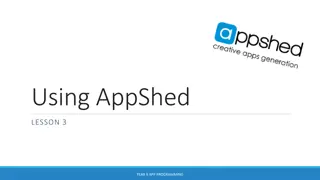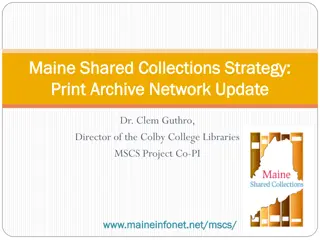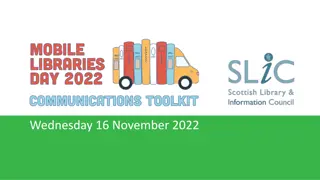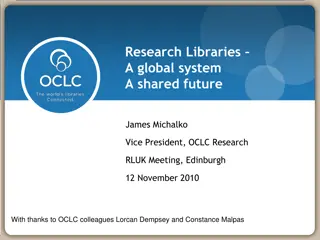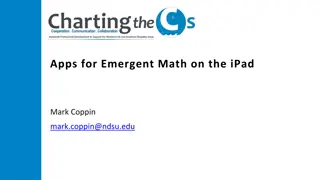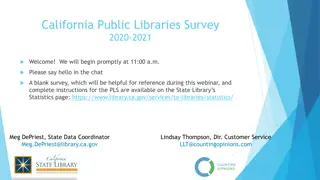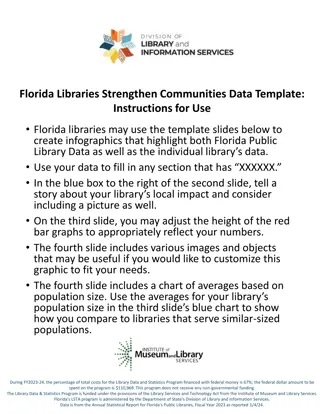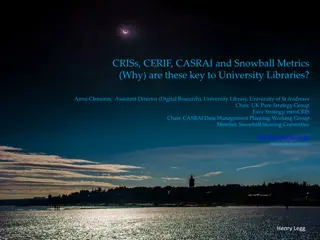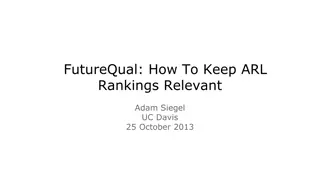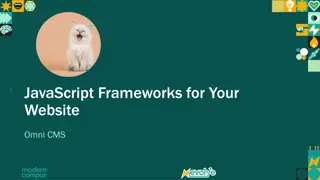Overview of Web Libraries, Tools, and Frameworks for Building Web Apps
Explore various client-side and server-side web libraries, tools, and frameworks such as Angular, Ember, Rails, Express, jQuery, d3, and more. Learn about the importance of web app frameworks, the challenges they solve, and considerations for choosing between server-side and client-side implementations. Discover popular frameworks as of November 2014 and get insights on making the right choice for your web development projects.
Download Presentation

Please find below an Image/Link to download the presentation.
The content on the website is provided AS IS for your information and personal use only. It may not be sold, licensed, or shared on other websites without obtaining consent from the author. Download presentation by click this link. If you encounter any issues during the download, it is possible that the publisher has removed the file from their server.
E N D
Presentation Transcript
Some cool web libraries and tools Lab 11 11/7
Here are some libraries/tools Client-side web app frameworks: Angular, Backbone, Ember, Meteor Server-side frameworks: Rails, Express, Django, Flask Utilities: jQuery, Underscore, Require Templates: Jade, Handlebars, Mustache Visualization: d3, Raphael, Processing Compilers: CoffeeScript, TypeScript Other: Bower, Leaflet
Web App Framework Useful if you're building a web app! You might not be: might be an interactive experiment on a Canvas or a game or a static web page or something. Does a lot of things You kind of have to decide this one up front They're all fine, just pick one. But do pick one, developing web apps frameworkless is awful.
Web App Framework Solve two main problems: Routing: how to map a URL to the code that handles it Templates: creating HTML dynamically using info from the database Of course there are a lot more problems too especially when you want to do newfangled fancy things
Server-side or client-side? Server-side: Rails, Express, Django, Flask Client-side: Angular, Ember, Meteor, Backbone Not really an "xor" you'll probably need both, but your choice will be which one does more work. Do you render templates, and do you handle routing, on the server or the client?
Which one should I pick? Try them all (good luck!) Weigh all the pros and cons ( also good luck.) Go with what's popular (not guaranteed to be awesome, but at least you probably will get a lot of stack overflow posts when you get stuck. and maybe some other people you know will work with it.)
Let's start with client side frameworks
No, but seriously, pros and cons http://www.100percentjs.com/backbone-or-angular-or- ember-here-is-my-choice-and-why/ http://www.airpair.com/js/javascript-framework- comparison http://readwrite.com/2014/02/06/angular-backbone- ember-best-javascript-framework-for-you http://www.quora.com/Client-side-MVC/Is-Angular-js-or- Ember-js-the-better-choice-for-JavaScript-frameworks
Vague hand waving Ember sounds pretty good, but I haven't used it. Angular can make for some very clean code but you run into scaling issues eventually if your code gets too big. Use Meteor if you are doing a lot of multi-user real-time things. Backbone is super lightweight; kind of too lightweight for my taste.
Angular which is the only one I've worked with extensively philosophy: "how we would create HTML/JS if we invented it today" What does it do for you? directives two-way data binding templates dependency injection Used by Google (for some things), kind of new so it doesn't have as wide adoption by big names yet.
Directives: reusable HTML elements <tabs> <pane title="Localization"> Date: {{ '2012-04-01' | date:'fullDate' }} <br> Currency: {{ 123456 | currency }} <br> Number: {{ 98765.4321 | number }} <br> </pane> <pane title="Pluralization"> <div ng-controller="BeerCounter"> <div ng-repeat="beerCount in beers"> <ng-pluralize count="beerCount" when="beerForms"></ng-pluralize> </div> </div> </pane> </tabs>
Two way data binding Model View Controller
Two way data binding <input type="text" ng-model="yourName"> <h1>Hello {{yourName}}!</h1>
Templates <span> 1+2={{1+2}} </span> <div ng-model="person"> hello {{person.name}} </span>
Dependency injection Makes testing easier/possible I'll talk more about it next week Angular also gives you a host of other goodies, but that's the main thing.
Ember Same data binding for templates, but less logic Components instead of directives Great comparison: http://www.quora.com/Client-side- MVC/Is-Angular-js-or-Ember-js-the-better-choice-for- JavaScript-frameworks Used by Zendesk, Square, Groupon
Backbone Philosophy: "an attempt to discover the minimal set of data- structuring and UI primitives that are generally useful when building web apps with Javascript." Data binding to views Event handling on any JS object Models that manage validation, access control, computed properties and sync to a data store on the server Used by rdio, foursquare, basecamp, airbnb,
Meteor designed for real-time, multi-user communication same basics: templates, data binding, event handling more of data persistence handled on client side (via mongo collections) so it's kind of bound to Node and MongoDB
Another tool to help choose: TodoMVC http://todomvc.com same app implemented in a ton of different frameworks.
Server-side web frameworks
In Javascript Just Node This is pretty simple, but kind of annoying to do anything complicated it can work if you're doing all your logic client side and your server is pretty dumb, just sending over all your JS. Express Lets you do more complicated routing Can render templates as well
In Python Django is older and full featured Flask is more minimalist and modern
In Ruby Use Rails; you're probably not even asking this question because Rails is kind of the #1 reason to use Ruby
In Java Gosh, I have no idea. Five years ago I'd say try Spring or JSP or GWT but honestly they're all kind of verbose because Java is. Still, you may work on one of them because Java is popular at Big Companies, because it's been around forever and therefore it's "faster" or "more stable" Scala and Groovy/Grails are kind of popular JVM languages, not java itself. Play seems to be a new popular thing but I have no experience
Dan's totally objectively correct views I like Flask + whatever client-side stuff I need for simple things, and MEAN (mongo, express, angular, node) for bigger things I'd like to try Ember or Meteor if I were doing a new project now, but I may also continue all Angular all day I dislike Django, Rails, and Backbone But this is not Expert Sage Advice; these are the ramblings of a part-time hacker, at best.
jQuery (see slides from last week)
Underscore "A mess of useful functional programming helpers" A lot of stuff I wish I had when I didn't have it. Collections: each, map, find, contains, sortBy, Arrays: first, last, union, uniq, Objects: keys, values, isArray, Functions: bind, partial, memoize, Other: random, escape (for html),
Require JS file and module loader. There's no #include/import built in to JS. allows you to define modules and require them:
Require define( //The name of this module "types/Manager", //The array of dependencies ["types/Employee"], //Function to execute when all dependencies have loaded. function (Employee) { function Manager () { this.reports = []; } Manager.prototype = new Employee(); return Manager; } );
Require require(["some/script.js"], function() { //This function is called after some/script.js has loaded. });
What are templates good for? inserting dynamic data (from the server, or from other JS logic) into your html you don't want to do this: $.each(messages.reverse(), function(index, message) { $('#messageList').append( '<li><span class="list-title">' + message.userName + '</span>' + '<abbr class="list-timestamp" title="' + message.datePosted + '"></abbr>' + '<p class="list-text">' + message.messageText + '</p></li>'); } });
Mustache "logic-less" no loops or ifs. well, that's kind of true, but they also have "sections" that do something for each thing in your data the benefit is that it's hard to accidentally put logic in your templates (which is bad because then it's hard to test and hard to tell what your code is doing)
Handlebars Like Mustache, and compatible, but with a little more logic Paths to reference arbitrary content in data: {{user.name}} instead of just {{name}} Helpers to render data in custom ways: Handlebars.registerHelper('fullName', function(person) { return person.firstName + " " + person.lastName; });
Jade Clean syntax, looks pythonish Allows inline JS (so logic)
Jade doctype html html(lang="en") head title= pageTitle script(type='text/javascript'). if (foo) { bar(1 + 5) } body h1 Jade - node template engine #container.col if youAreUsingJade p You are amazing else p Get on it! p. Jade is a terse and simple templating language with a strong focus on performance and powerful features.
Choosing a template language is a lot less important than choosing a web framework a lot of time the choice will be made for you angular uses its own built-in templates, ember uses handlebars, express uses jade in its docs
But wait, didn't we already learn canvas? Yeah, but the drawing library we built up is probably too low level to help you make progress quickly.
d3 vector graphics based on data very popular, very slick can make very complex and interactive data visualizations see gallery on http://d3js.org/
d3 Selectors kind of like jquery Enter and Exit to affect how new data points that are added to the selection should be, and what to do when points leave the selection Examples: http://bost.ocks.org/mike/circles/
Raphael Vector graphics (SVG) on the web More straightforward than d3; more drawing, less data- representation. demos: http://raphaeljs.com/
Interlude: vector or raster? what's a case where vector graphics would be better? what's a case where raster graphics would be better?
Processing Simple; java-ish language. "setup()" and "loop()" functions provided for you, as well as primitives for line(), rect(), etc. Useful for low-level things. Kind of like what we could have made if we developed P2 into a full-fledged useful library. neat examples: http://beesandbombs.tumblr.com/
I thought Javascript was interpreted it is but you can compile down to Javascript, to make reading/writing code easier.





